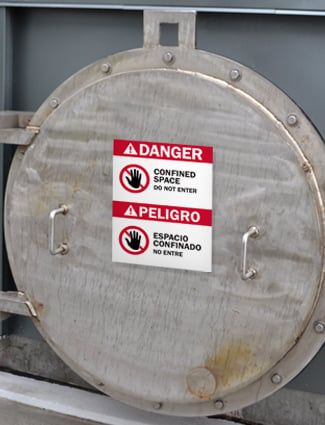ANSI Harmonizes Safety Colors with ISO
03
February,
2023
2 MINUTE READ

Roses are red, violets are blue ? or are they? Throw in some shade or light, and red isn't just red anymore. One person might be looking at a fire red stop sign, while another might see a crimson red stop sign. Do both reds still convey the same message? In December 2017, the American National Standards Institute (ANSI) released an update to Z535.1 to bring its color code more in line with the International Organization for Standardization (ISO). ANSI Z535.1 includes the technical definitions, color standards, and color tolerances for safety colors. These colors are used in safety signage and other warning materials. Standardizing the color system for safety provides a consistent way to communicate hazardous situations and environments visually.
 Aligning of Standards
Aligning of Standards
In establishing a uniform system for specifying safety colors, ANSI Z535.1-2017 harmonizes with ISO safety colors (ISO 3864-4) and the Code of Federal Regulators. According to Donna R. Ehrmann, former chair of ANSI Z535.1 safety colors, the changes to the standard are significant. "Prior editions of this standard were difficult to understand and did not provide enough information to specify safety colors consistently," she said.
A major instinctual cue everyone shares is the knowledge that color can tell how dangerous something might be. The goals of revising ANSI's safety color standard were to minimize technical references to color tolerance charts and instead focus on achieving uniform safety colors. This simplification is meant to create consistency in safety colors for printing spot or process colors, displaying online manuals, or digitally printing safety signs or labels.
According to ANSI, some of the primary changes present in Z535.1-2017 make the standard easier to understand and more user-friendly. To help readers understand references in the standard, definitions have been included. Greater emphasis has been placed on what can affect a safety color's appearance and can cause it to fall outside the acceptable tolerance limits, and fluorescent safety color information has been updated, ANSI said in a press release.
Communicating with Color
Product safety label standards help manufacturers reduce risk and expand global markets while communicating safety to international audiences. Using risk-assessment methodologies as well as ANSI and ISO compliant safety labels, manufacturers can better prevent accidents while meeting export requirements internationally. Use safety labels as visual cues to quickly communicate temperatures, chemical compounds, and safety equipment. Identify the severity potential of a hazard: red for danger, orange for warning, and yellow for caution. Alert non-hazard messages with blue for notices and green for safety.
RELATED RESOURCES

Re-evaluate Electrical Work Performance
Electrical work is dangerous and causes numerous injuries and deaths per year. Workplaces can take the time ...
Read
4 Wayfinding Errors and How to Fix Them
Employees should be able to find their way safely and efficiently around the workplace. When crucial signage ...
Read
MSHA Coming to Collect on Scofflaw Program
Mining companies cited years ago have not been paying their fines, and the Mine Safety and Health ...
Read.png)


